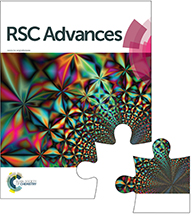Welding partially reduced graphene oxides by MOFs into micro–mesoporous hybrids for high-performance oil absorption†
Abstract
Partially reduced graphene oxides (PRGOs) with a small number of COOH groups remaining at the edges were interlocked by UiO-66-NH2 nanoparticles into hierarchical porous hybrids (PRGO@UiO-66-NH2) during the synthesis of UiO-66-NH2 in the presence of PRGOs, in which the UiO-66-NH2 nanoparticles provide micropores and the interlocked PRGO skeletons provide mesopores. The peak intensity of the functional groups on the PRGO@UiO-66-NH2 hybrids decrease greatly when compared with the GO@UiO-66-NH2 hybrids and the UiO-66-NH2 nanoparticles, and the number of –COOH at the edge of the PRGOs are approximately 6.3% after reduction, which is confirmed by the FT-IR and XPS results. When the PRGO@UiO-66-NH2 hybrids were embedded in their macropores via hydrogen bonding, melamine foams (MFs) were able to effectively absorb a variety of water-immiscible organic solvents from oil/water biphasic mixtures and, at the same time, suppress water infusion due to Cassie-state surface superhydrophobicity with a water contact angle of 154.2° in air. After 10 cycles, the PRGO@UiO-66-NH2-laden MFs exhibited water contact angles of 148.3°, which indicated that the composite MFs had excellent stability and recycling ability after 10 cycles. The PRGO@UiO-66-NH2-laden MFs had an oil absorption capacity of >10 000 wt% of the dry mass of absorbents and water absorption capacity of ≈1.76 wt% of the adsorbate, thus highlighting the high absorption selectivity of oil over water.



 Please wait while we load your content...
Please wait while we load your content...